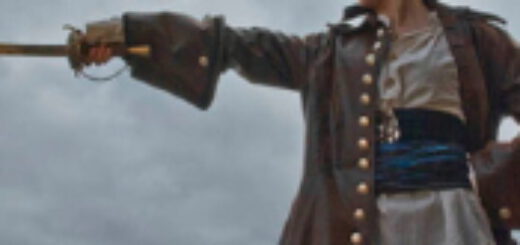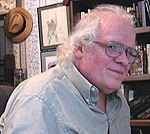JOHN OSTRANDER: Pro Advice – Hit By a Bus
 From time to time I’m going to use this space to talk about professional concerns gleaned from my experiences of the past twenty-five plus years in the industry and pass on words of advice that I got in that time.
From time to time I’m going to use this space to talk about professional concerns gleaned from my experiences of the past twenty-five plus years in the industry and pass on words of advice that I got in that time.
For example – if you go to a Convention and you’re a pro, you’re probably going to be asked to autograph copies of your work. Here’s something I didn’t know when I began and was taught by another pro: keep your autograph separate and different from your legal signature (the thing you sign checks and binding contracts with). Walt Simonson, for example, has a great autograph – looks like a dinosaur. I doubt he signs his checks that way. It makes sense. If your autograph is the same as your legal signature, it makes it easier for someone to forge that signature and that’s not good.
Here’s another bit of advice. I was once negotiating a contract at one of the major companies and I had a question about something in the contract that no one could answer. I was told, “Oh, John. Just go ahead and sign it. We’re all family here.”
My answer was – no, we’re not. I know who and what my family is and the company isn’t it. I applied my “Hit By A Bus” theory which goes as follows: if everyone I knew (and liked) at a given company all went out to lunch together and they were all hit by a bus and killed, all I would have would be the contract as written.
I have lots of friends at lots of different companies in lots of different positions ranging from editorial to management to production to the business end. They’re all personnel and can be promoted, demoted, fired, leave, and so on. The company itself can merge with another, change divisions, be sold, be bought, and more than one has gone out of business out from under me. Businesses will make business decisions that are usually based on financial reasons. The famous line from the Godfather, “it’s not personal; it’s just business” remains true.
I don’t fault businesses for that. It’s what they are. I may have friends at a certain business and, yes, I often depend on them to be friends. I never expect a corporation to be my friend. I don’t care what a commercial that’s trying to sell you something tells you to the contrary. A business is not your friend and certainly isn’t your family. They are a corporate entity and they will act like one. Don’t expect anything different.
Short form: read the contract, any contract, and know what you’re getting into. If you need a lawyer to explain it to you, get one. Don’t take the word of anyone working for the company as to what it means; make sure it’s someone who is not part of the corporation. That’s true outside of comics as well as in. If it isn’t in the contract, it doesn’t exist legally. There is no “understanding,” there’s only what’s on paper. Know that before you put your legal signature – not your autograph – on the dotted line. You and your family will be happier as a result.
And watch out for killer buses.
MONDAY: Mindy Newell
Related articles
- JOHN OSTRANDER: How Piracy Made Me A Comic Book Writer (comicmix.com)







 Editor’s note: We were all ready to discuss who you should be focusing on in your graphic novel, and then we remembered that John Ostrander, writer of GrimJack, Munden’s Bar, Star Wars: Legacy and Suicide Squad, had already answered the question for us a while back. So we’re reprinting his piece from October 25, 2007.
Editor’s note: We were all ready to discuss who you should be focusing on in your graphic novel, and then we remembered that John Ostrander, writer of GrimJack, Munden’s Bar, Star Wars: Legacy and Suicide Squad, had already answered the question for us a while back. So we’re reprinting his piece from October 25, 2007.  As I’ve mentioned before, one of my favorite films is a fine Irish delight called Waking Ned Devine. The closing theme is a lovely version of the Irish tune Parting Glass, an appropriate song to come to mind for many different reasons on this, my final column at ComicMix. The refrain of it reads like this:
As I’ve mentioned before, one of my favorite films is a fine Irish delight called Waking Ned Devine. The closing theme is a lovely version of the Irish tune Parting Glass, an appropriate song to come to mind for many different reasons on this, my final column at ComicMix. The refrain of it reads like this: I was at the FallCon in St. Paul, Minnesota, a few weekends back. Nice little to medium sized Con, the sort I really enjoy these days. You get a chance to talk to the fans and see a few other friends and old pros. I spent some nice time with Pete Tomasi and sat across from Howard Chaykin at a wedding reception/dinner that was held at the Con.
I was at the FallCon in St. Paul, Minnesota, a few weekends back. Nice little to medium sized Con, the sort I really enjoy these days. You get a chance to talk to the fans and see a few other friends and old pros. I spent some nice time with Pete Tomasi and sat across from Howard Chaykin at a wedding reception/dinner that was held at the Con. 
 I liked Paul Newman. I should’ve hated him; bastard was too damn good looking and should’ve given me an inferiority complex. The fact is I didn’t always like how I looked but what I learned was that he didn’t always like the way he looked, either. Newman felt his looks got in the way of his being an actor, affected the roles he was offered, the roles he wanted to play. He was a character actor trapped in a leading man’s body. That allowed me to identify with him as a person as well as an actor.
I liked Paul Newman. I should’ve hated him; bastard was too damn good looking and should’ve given me an inferiority complex. The fact is I didn’t always like how I looked but what I learned was that he didn’t always like the way he looked, either. Newman felt his looks got in the way of his being an actor, affected the roles he was offered, the roles he wanted to play. He was a character actor trapped in a leading man’s body. That allowed me to identify with him as a person as well as an actor. Every single person who reads something I’ve written, including these essays, has a right to their own opinion of it – good, bad, indifferent. That goes with the territory. Sure, it’s nice to hear that the reader loves what I’ve done but I’m a big boy; I can take a brickbat or two. My rules are generally 1) actually read what I’ve done, 2) know what you’re talking about and 3) put a little effort into the critique.
Every single person who reads something I’ve written, including these essays, has a right to their own opinion of it – good, bad, indifferent. That goes with the territory. Sure, it’s nice to hear that the reader loves what I’ve done but I’m a big boy; I can take a brickbat or two. My rules are generally 1) actually read what I’ve done, 2) know what you’re talking about and 3) put a little effort into the critique.  As reported here on
As reported here on 








